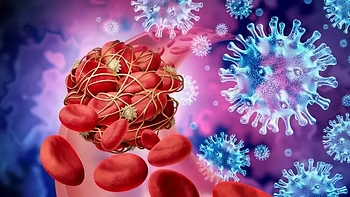Listen up, dear reader! There’s something lurking in the blood of some individuals battling those persistent post-Covid symptoms. It’s called D-Dimer. Ever heard of it? No? Time for a quick and juicy rundown.
What Does Current Research Say?
Recent research (that’s right, hot off the press!) indicates that 25% of individuals with long-lasting Covid symptoms have shown increased D-Dimer levels. That’s a quarter of them! The numbers are shouting, and they’re hard to ignore.
A Picture is Worth a Thousand Words
Picture this. You’re gazing at a snapshot of your blood. Those tiny red dots? They’re your hard-working red blood cells. But wait, what’s that white gunk surrounding some of them? That’s your D-Dimer fibrin. In simple terms, too much of this ‘white stuff’ means your blood’s getting gooey and thick.
Why Should You Care?
A thicker bloodstream isn’t just an odd fact for your next trivia night. Here’s the kicker: Diseases love setting up camp in bodies where the blood’s all gloopy. And this sticky situation is connected to Covid-19.
Real-Life Evidence: A Glimpse From The Trenches
Case in point: A client of mine. Post-long Covid, we checked his D-Dimer levels. Want a number? A whopping 1.48. But what’s the ideal? Glance to the right, and you’ll see the desired number: below 0.49. This test, my friends, is your golden ticket. It’s a measure of where you stand now and after treatments, showing the progress in alleviating those lingering Covid blues.
Your Next Step? Knowledge is Power
Now that you’re in the loop, don’t just keep this nugget of wisdom to yourself. Like, comment, share. Spread the word, and perhaps, help someone in need. Remember, it’s always the little things that make a big difference. Know your D-Dimer, and stay ahead in the health game.
Frequently Asked Questions (FAQ)
D-Dimer is a protein fragment produced when blood clots dissolve. Elevated levels can signal excess fibrin and abnormal clotting, which research shows may affect around 25% of people with Long Covid.
High D-Dimer levels suggest your blood may be thicker and more prone to clotting, which can increase inflammation and create an environment where chronic illness thrives.
A healthy D-Dimer reading is typically below 0.49 mg/L FEU. Levels above this may indicate abnormal clotting activity and warrant further investigation.
Tracking D-Dimer levels gives insight into how your body is responding to treatments and lifestyle changes. It helps monitor progress and guides strategies for reducing lingering Long Covid symptoms.









